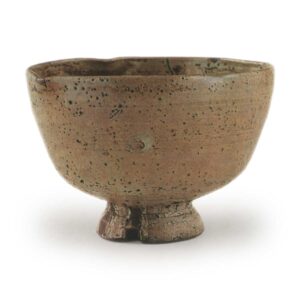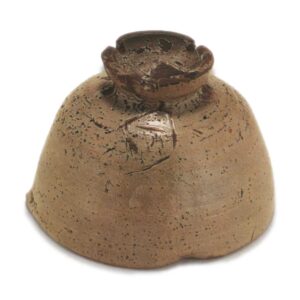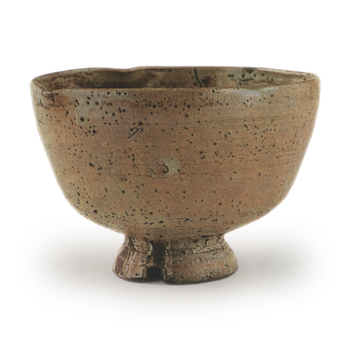

Height: 8.5-8.9cm
Diameter: 10.9-12.8cm
Outer diameter of foot ring: 5.4-5.6cm
Height of foot ring: 1.9cm
This is a type of so-called conical bowl, but the origin of the name “harigi” is unclear. However, the name “hariki” has been used since ancient times to refer to bowls, plates, and cups with a rim that is bent into a flower shape, and the name may have been given because the way the rim is pinched out on two sides resembles the way fabric is stretched over a wooden frame. Also, the Shonzui-te dyeing technique is used for the middle-sized plates, and they are called “harigi-dashi” (needlewood plates), and they have ridged edges, so perhaps this is where the name comes from.
The foot of the bowl is a distinctive feature of Kureki tea bowls, with a square cut-out on three sides, creating a three-sectioned foot, and a small cape protruding from the center of the foot. The cut-out at the foot is very sharp, and when viewed from the side, it looks as if a round bowl is sitting on a stand.
The rim is chamfered and flared out from the waist to the rim, giving it the characteristic shape of a bowl with a wide opening. The inside of the bowl is deep, and the central part of the bowl, where the tea is kept, is particularly deep, as is to be expected of a conical bowl.
The overall color is a bluish-green, with patches of lighter and darker glaze, but the darker patches are a strong bluish-gray, while the lighter patches have a reddish tinge and appear as a soft light pink. Small holes are scattered all over the surface, and these also form a scene.
The inside of the foot ring is also glazed, but about one third of it has flaked off to reveal the clay body, and the glazed part forms a pattern resembling Japanese apricot bark. The apricot bark pattern also appears on the outside of the foot ring from the waist up, and the foot ring area has a very dignified appearance. In addition, the finger marks from when the glaze was applied around the foot ring are interesting. Apart from one crack around the rim, it is flawless.
The date of manufacture of this type of three-cracked foot ring tea bowl is unclear. Some of them may be old works, that is, works made before the Imjin War (1592-1597), but most of them are probably works made after that. Although this tea bowl has a slightly artificial feel to the knob at the rim, the overall workmanship is very solid, and it is thought that it may be an old work made as a ritual vessel. The five tea bowls listed in the Taisho Meiki Kan, including this one, and three other bowls that I have seen, all have three-part rims, with the exception of two bowls. The bowl that is most similar to this one is the Fujita family tea bowl. However, the workmanship of this bowl is also interesting, and it seems to stand out from the others.
On the inside of the paulownia wood box lid, the words “Five-piece lacquered wood, three-split foot” are written in ink, but the writer is unknown. However, judging from the fact that it was once in the collection of the Date family of Sendai, and from the handwriting, it is thought to be the work of a tea master’s assistant rather than the tea master himself. Also, on the wrapping paper, it says “Kiri (a phonetic equivalent for the character for ‘drill’) Goki Haruki, tea bowl, formerly owned by the Sendai feudal lord, a famous item (of rare quality)”.
It is said that it was deposited with Kajima Seibei of Fukagawa, Edo, as collateral for a loan of 40,000 ryou from the Date family, and then became the property of the same family. After that, in 1902, it left the Kajima family and became the property of the Umakoshi family, and after the Pacific War, it returned to the current owner’s possession.



